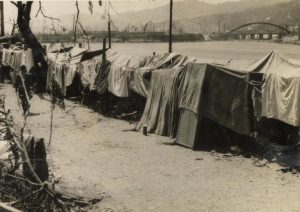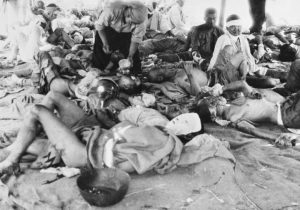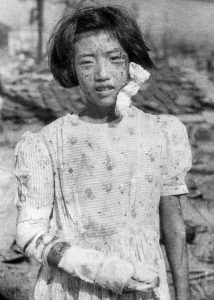Documenting Hiroshima of 1945: August 9, severe injuries, radiation from A-bombing
Aug. 9, 2024
“My hand hurts, my hand hurts”
by Fumiyasu Miyano, Staff Writer and Kyosuke Mizukawa, Senior Staff Writer
On August 9, 1945, three days after the atomic bombing, a girl was photographed amid the scorched ruins of Hiroshima City. The bandages applied to her cheek and right arm in the photo give the appearance she was in great pain. The photograph was taken by Yukio Kunihira, a staff photographer for the Mainichi Newspapers Osaka Head Office who arrived in Hiroshima that day and later died in 2009 at the age of 92.
The girl in the photo was Sachiko Fujii, 10 at the time and a fifth-grade student at Noboricho National School (present-day Noboricho Elementary School, in Hiroshima’s Naka Ward). Ms. Fujii experienced the atomic bombing at home in the area of Yayoi-cho (in the city’s present-day Naka Ward), located about 1.2 kilometers from the hypocenter. Her face and the nape of her neck had been injured by flying pieces of glass blown by the bomb’s blast. She also had severe burns on her right arm due to exposure to the thermal rays generated by the bombing.
Inspired by the photo, her oldest son, Tetsunobu Fujii, 64, a resident of Tokyo, has been retracing the steps his now-deceased mother took after the atomic bombing. Mr. Fujii said, “I believe her frown in the photo indicates she was enduring the pain from the burns. I heard she repeatedly cried out while fleeing that, ‘my hand hurts, my hand hurts.’”
Contracted breast cancer 24 years later
Her bandaged right hand’s fingers had become stuck to each other because of the burns. She was forced to later undergo surgery to separate her fingers one by one. By the time she graduated from high school, she had not experienced any major diseases and started a family in Hiroshima City. However, 24 years after the bombing, she developed breast cancer.
Tetsunobu was still a third-grade elementary school student at the time. His mother recovered after undergoing surgery, but he said, “She began to complain about being in pain after I entered junior high school. When she was in severe pain, she would even sleep during the day.” After repeated hospitalizations, she died in 1977, when Tetsunobu was a second-year high school student. She was 42. The cancer had spread throughout her body, and she was diagnosed with bone marrow cancer at the end.
An epidemiological survey of the atomic bomb survivors conducted after the war revealed that A-bomb radiation had increased the risk of cancer development among survivors. With no awareness of that fact, Hiroshima’s citizens had been exposed to high radiation doses. The hidden inhumanity of nuclear weapons is etched into photos of members of the public taken after the bombing.
Aid and relief system also destroyed
August 9 was the date on which the U.S. military dropped a second atomic bomb on Nagasaki. On the same day, certain photos and documents record the critical status of the aid and relief system in Hiroshima City.
Yotsugi Kawahara, then a member of the Army Shipping Command’s photography team who died in 1972 at the age of 49, accompanied members of an Imperial General Headquarters survey team that had arrived in Hiroshima by air on August 8, and traveled with them around the city. An objective of the team’s visit was to verify whether or not the bomb dropped on the city was an atomic weapon, based on the announcement made by then-U.S. President Harry Truman on the early morning of August 7 (Japan time) that an atomic bomb had been dropped.
Japan’s Army Ministry survey team, composed of instructors at the Army Medical School in Tokyo, also entered Hiroshima with the Imperial General Headquarters survey team. The Army team visited an army hospital in the city. The Hiroshima Second Army Hospital, located in the area of Moto-machi (in the city’s present-day Naka Ward), was totally destroyed and burned to the ground at a location around 1.1 kilometers from the hypocenter. Mr. Kawahara took photos capturing the tragedy unfolding at a temporary relief station that overflowed with the wounded. The relief station was comprised of tents established on an embankment of Honkawa River near the hospital.
“Bulletin No. 4,” released by the survey team on August 9, 1945, mentioned the collapse of the city’s medical system.
The bulletin included the description, “Most of the hospitals and clinics in Hiroshima have been burned to the ground.” In addition, it indicated, “Most managers and employees of the prefectural and city governments’ public health (welfare) departments are dead or wounded, decreasing their functions significantly.”
Such is the record of the reality of the nuclear attack, which led to the destruction of hospitals and government offices designed to save the lives of citizens with the detonation of a single bomb.
(Originally published on August 9, 2024)










